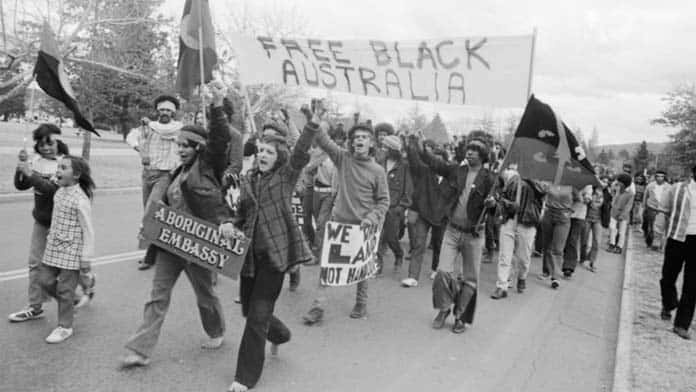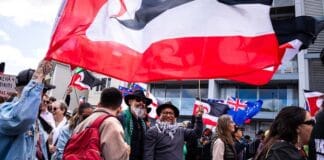The establishment of the Aboriginal Tent Embassy on Invasion Day in 1972 was one of the high points of the Aboriginal rights movement. It showed how protest could put Aboriginal rights on the agenda and win real changes.
In 1971 a Supreme Court challenge by the Yirrkala people against the Nabalco mining company ended with a ruling that Aboriginal people had no rights to their land under the law.
Then, on the eve of Invasion Day in 1972, Liberal Prime Minister Billy McMahon refused to recognise land rights through legislation.
The next day four Aboriginal activists, Michael Anderson, Billy Craigie, Bertie Williams and Tony Coorey, travelled from Sydney to Canberra in a car driven by Communist Party photographer Noel Hazard. They planted a beach umbrella on the lawns of parliament house and held placards that read “Land rights now or else” and “Legally this land is our land. We shall take it if need be”.
Originally this was intended as a protest stunt. But when they arrived they discovered that a legal loophole allowed camping on the Parliamentary lawns, and began erecting tents. The Tent Embassy became a central rallying point for the Aboriginal rights movement.
After the 1967 referendum extending citizenship to Aboriginal people, campaigners had hoped conditions in Aboriginal communities would improve.
But little changed. The government continued to revoke Aboriginal reserve land, forcing families into the cities. Aboriginal people lived in squalid housing and segregated communities, encountering daily police violence.
The failure of the Yirrkala court action and McMahon’s subsequent rejection of land rights showed many people that neither parliament nor the legal system would end the discrimination they faced.
Radicalism
The Tent Embassy drew inspiration from the student and working class radicalism of the 1960s and 1970s, including widespread strike action, the movement against the Vietnam War, anti-colonial struggles across the world and the US civil rights movement.
Demands for land rights had become central. In 1966 over 200 Gurindji on a cattle station in the NT began a three-year strike against virtual slave conditions. White unionists toured Gurindji people around workplaces nationwide to speak about their struggle and raise funds.
The Gurindji not only won equal wages but, eventually, ownership of their land. Their strike put land rights on the political agenda.
The movements of the 1970s brought real gains for Aboriginal people.
Demands
The Tent Embassy’s demands included an Aboriginal controlled state in the NT; legal title and mining rights to all reserve lands, as well as the land around capital cities; the preservation of sacred sites; and compensation for lands lost including a $6 billion down payment.
Underlying them was a desire for an end to the policy of assimilation and a demand for self-determination and Aboriginal control over their land, communities and lives.
The Whitlam Labor government rode to power at the end of 1972 on the back of this period of ferment. Whitlam abolished assimilation as official policy, creating the first Department of Aboriginal Affairs. His government also drew up the NT Land Rights Act (eventually passed under the subsequent Liberal government), finally giving the Gurindji and many other Aboriginal communities in the NT back their land.
These steps showed the power of political protest to win gains. But the government never fully delivered self-determination or the compensation for dispossession that the movement demanded. In the decades since, many of the gains around self-determination and Aboriginal control have been wound back, seen most starkly in the takeover of Indigenous communities through the NT Intervention.
Rates of Indigenous imprisonment are the highest in the world, record numbers of Indigenous children are being removed from their families, very few Indigenous people have meaningful rights over land and constantly see their country destroyed by development.
We need a return to the protest politics of the Tent Embassy today if there is going to be any serious progress for Aboriginal rights.
Voices from the 1972 Tent Embassy
The Tent Embassy stood on the lawns outside Old Parliament House in Canberra until July when the Liberal government passed a new law making camping there illegal. Without warning 100 police descended on the Embassy on 20 July and violently removed the tents, arresting eight people. Three days later, demonstrators tried to re-establish the embassy without success.
Then on 30 July the movement organised a 2000-strong march including students, unionists and workers from across Canberra—led by at least 250 Aboriginal people who travelled from as far as Brisbane. It was the largest land rights demonstration in Canberra’s history. Below are excerpts from three speeches delivered to the crowd on the day.
Chicka Dixon, wharfie, unionist and Aboriginal activist
In 1968, if my memory serves me correct, we marched for land rights here, from the university—three Blacks and about 200 university students. Why are there only three Blacks? Because they were too frightened. They were frightened of the establishment. They were frightened to stand up and be counted.
Now, because of what occurred here on Thursday and last Sunday, when the Gestapo [the police] came in and used boots and everything to suppress our people, we’ve got Aboriginal people here from every state—these are Black people that care that our people were being hammered over the principle of land rights. For six months we’ve had a tent [embassy] here in [an act of] passive resistance. Then all of a sudden in come the powers that be and rip down the tent.
The reason why the tent [embassy] was put up was because on so-called Australia Day, the Prime Minister brought down a decision on land rights as far as the Liberal Party were concerned.
Every other Indigenous race of dispossessed people in the world have been given land rights. Land is our major concern.
And if the people allow the government to move in heavily on passive Aboriginal people [to disperse the Tent Embassy] that is an indictment on the Australian people. The most vital thing as I see it is that if you’re not going to become part of the solution, then we’ll have to consider you part of the problem.
Bob Pringle, NSW President, Builders Labourers Federation
As far as I’m concerned, the police force that I saw here last weekend were just a mob of racist, fascist pigs. I disagree that it’s just their job. Because the Builders Labourers in New South Wales have been asked to do a lot of jobs, like pulling down buildings that have historical value, like building on kids’ playgrounds, like tearing down the last bit of scrub land left on the Parramatta River—and we refused. So, if these thugs have got any real guts, they ought to refuse [to disperse the Embassy].
And as far as saying that a change of government is going to assist the Aborigines, I think that it will be because of the action of you people here today, that’s put pressure on this government and any other government that’s going to be [formed].
We are a racist nation and unless we face up to that fact then we’re having ourselves on. If it wasn’t for actions like this, the Labor Party wouldn’t take any more action than the present government. We’ve got to fight.
Today we have struck a blow. We’ve stood by and let our governments enact a policy of genocide against the Aborigines. And I believe that Aboriginal people in Australia are worse off than Blacks in South Africa, because in South Africa the Blacks are the labour force—so at least the government’s got to keep them healthy. But because the Aboriginal people in this country are only 2 per cent of the population, they’re not a big section of the labour force.
So the policy that this government is enacting [is designed to see them] wiped out slowly. I believe that it’s worse than apartheid [in South Africa] and unless we stand up and are prepared to fight it’s going to go on.
There’s eight union officials here today. I got up on the Labor Council floor in New South Wales last Thursday night and put forward a motion that the Labour Council should support this Embassy going up here today. I got 20 votes out of 106.
It’s only pressure from the people that’s going to change things. It’s the power of the people that we’ve got to be looking for.
Ken Brindle, Aboriginal activist
I was up in Kempsey on the far north coast [of NSW] when I saw [the Tent Embassy] on television. There were about 15 or 16 young Kooris watching television with us. They were a bit shocked by what they saw, but also elated and very, very proud that Aboriginal people were proving to the world that they were prepared to fight for what was theirs.
And they weren’t just going to watch their white mates go and fight for them but were going to fight for themselves. This is what this is all about today.
This will be world news, but it’s not so important for the people around the world to see this as it is for Aboriginal people that are living in huts and shacks and shanties in places like Menindee, Bourke, Collarenebri, Toomelah, places right out of sight of the government …
The government’s policy towards Aborigines particularly in isolated places where they’re living in poor conditions is that they [will do nothing for them, claiming they] can’t build houses for them because there’s no work there for them there.
This Embassy doesn’t only stand for Aboriginal land rights; it stands for Aboriginal equality. Aborigines need more than land rights, they need the opportunity to be given a decent education and to be able to stand up and take their place in society.
I got a terrific kick out of out of coming down and marching with my own people, and from all the support. But Aboriginal people are such a minority in this country that we cannot succeed without the sympathetic support of the European Australians.
The Koori History Website has a treasure trove of images from the first six months of the Embassy.






